, Author at INTO THE LIGHT
Events
On , | No Comments | In Events | By
Riga, Latvia 23 November 2014
On , | No Comments | In Holocaust, Riga | By
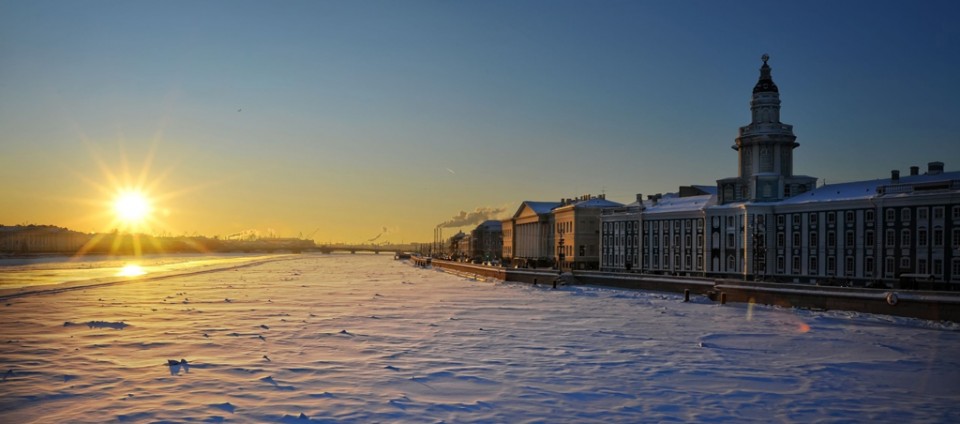
After spending a few days in St. Petersburg, I flew back to Riga, Latvia, yesterday. On the plane I asked myself how I felt, returning after 10 years. Part of me does not want to look again at what happened here over 73 years ago. My breath was shallow, and I felt like I was physically bracing myself for this visit. I plan to go to Kalman Aron’s home, the ruins of his neighborhood synagogue, the ghetto where he was imprisoned for 2 ½ years as well as the killing fields in Rumbula forest where his mother, Sonia, was killed with 25,000 other Riga Jews on 2 days in 1941. So I ask myself:
How do I ground myself and stay fully in my body?
How do I honor and hold all involved—the victims and the perpetrators—in light and love?
How do I heal the fears, shadows and darkness in my own body and transmute them into light?
I do not know the answers. I think this is a practice. But I am ready to see the places that defined Kalman Aron’s life.
I first visit his home on 40 Moscow Street. I looked and looked for it ten years ago, but I only had a description: a 5-story building with a courtyard and a two-story building at the back of the courtyard, facing the Daugava River. Kalman lived on the second floor at the back, overlooking the river. I found it today. It is in the photo across the street from me where a man is entering the five-story building. I walked around the back and saw the small building where he lived and I saw the window Kalman looked out across the river to an island where his first “love” lived with her mother. He proudly took her to a ball at the his art school, the Riga Fine Arts Academy. After the Germans entered Riga on July 1 of 1941, he snuck across the river to the island to see if they were OK. The small home was empty. Mother and daughter were gone, never to be seen again.
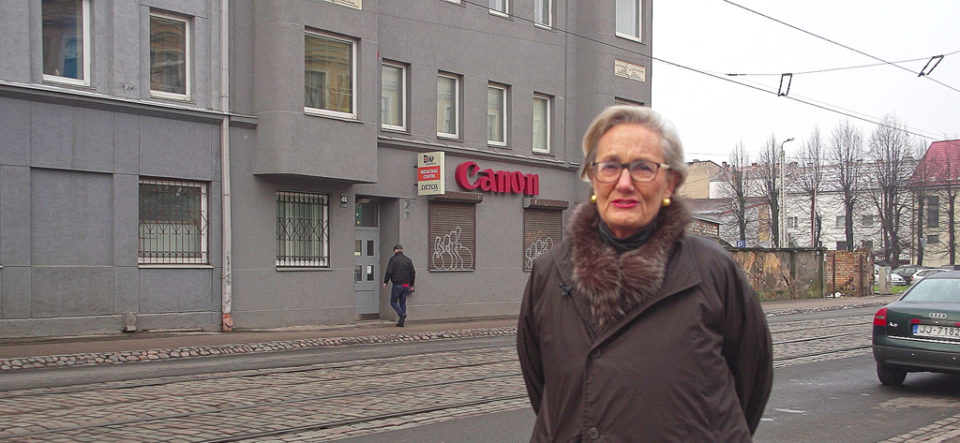
I next go to the memorial for the Choral Synagogue in Kalman’s neighborhood. Several hundred Jews, hiding from Lithuania, were burned alive when the Nazis locked the doors and set it on fire. Kalman saw the flames. Since I was here in 2004 a new white monument has been built to honor the Latvians who risked their lives to save Jews by hiding them in their homes. Throughout Latvia 729 Jews were hidden, of which 544 survived. In Riga alone 256 were hidden, of which about 200 survived. Janis Lipke, who saved over 50 Riga Jews, is listed on this monument as well.
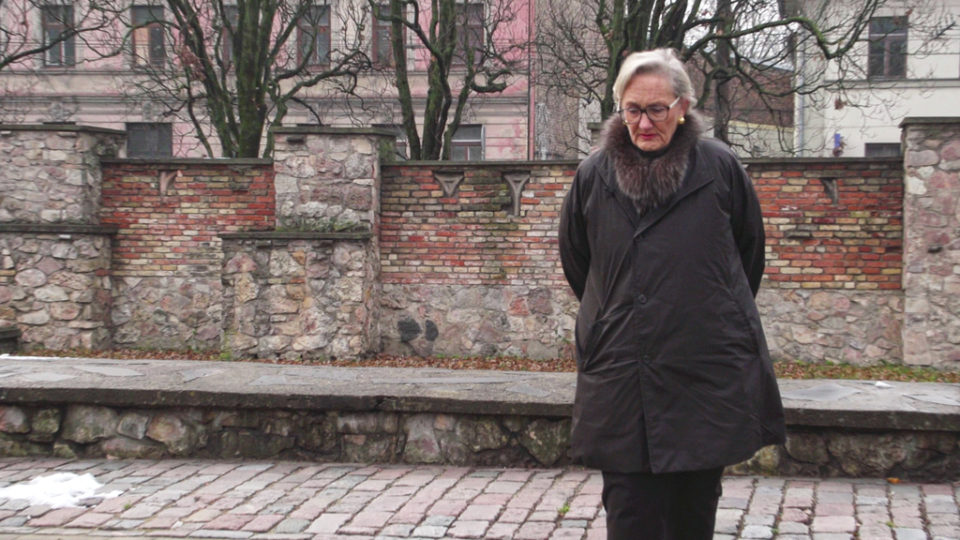

I then stop at the Old Jewish Cemetery. Founded in 1725, it was the first Jewish cemetery in Riga. By the end of the 1930s it was full. On July 4, 1941, when the Nazis burned all but one synagogue in Riga, they burned the buildings associated with the cemetery. They later buried in mass graves Jews who died in the Riga ghetto. Today it is a park although stones remain from old graves.

After having lunch, I go to Ludza Ilea where Kalman, his mother, Sonia, and his older brother, Henech, were imprisoned in the Riga ghetto. Eight thousand, mostly Russians, lived in the 8-block area. The Nazis moved them out and moved 30,000 Riga Jews into these small two-story wood clapboard houses. Kalman shared one room on the second floor with his mother and brother. The ghetto was closed in September of 1941, and every day he had to walk through the guarded gate to go to work and to return. A photo below shows me looking at a map of the ghetto on Ludza’s street where they lived with my interpreter, Victoria. The other photo shows the entrance to the ghetto during the war. I walked these streets in 2004, but I only recently found his address on Ludzas Iela 75/77.
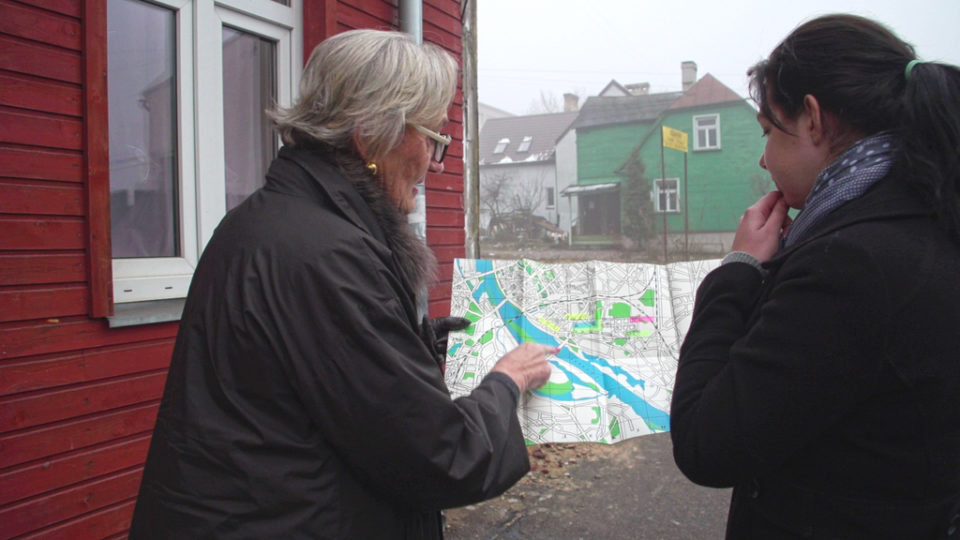
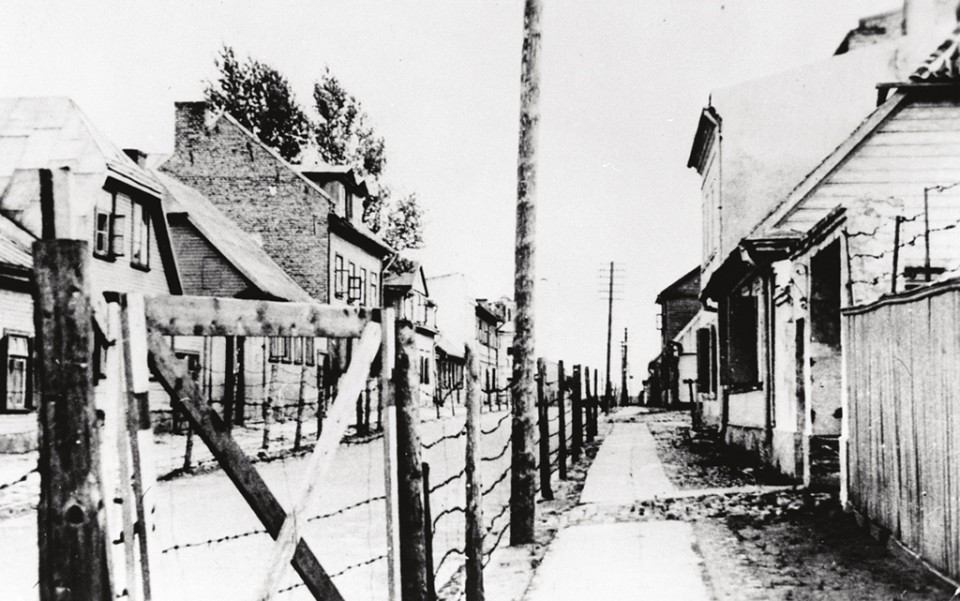
Finally, I drive to Rumbula forest where Kalman’s mother was brutally executed along with 25,000 other Jews in 1941. This is the most difficult visit. Today there is a memorial amidst the large trenches the Nazis prepared for the Riga Jews. They lined the prisoners up in single file; told them to put their shoes in one pile, their clothes in a second one and walk to the trenches. They were then told to lie down in the trench where they were shot, and as one layer of people was executed, a second group of human beings were told to lie down on top, and of course they were then shot. This continued the afternoon and early morning of November 29/30 and then again on December 8. We know exactly what happened because a young girl, Frida Michelson, dropped down in the shoe pile, hiding; then waited until it was safe; and she returned to the ghetto to report what had happened. She wrote the book: I Survived Rumbuli.
In 2004 to honor of Kalman’s parents, Claim and Sonia, I arranged to have a stone placed with their names engraved at this memorial. I have a photograph of it, but today I could not find it. It was hard to read the engraving on the stones damp from fog.
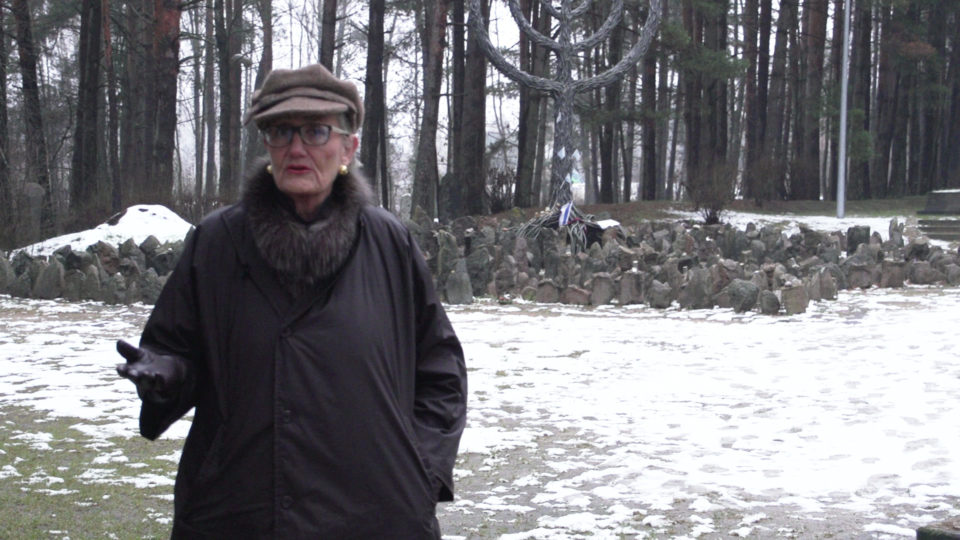

As I stood on this ground, I focused on Kalman’s gifts and legacy. His parents can be proud and grateful that he survived and maintained his integrity; that he was faithful to his muse, creating art; and that he found peace in his 9th decade after choosing to tell his story. I honor him, all his kindred spirits who survived and those who died in the Holocaust. May their sacrifice invite us all to resolve human conflict peacefully and no longer resort to killing as a solution to anything.
Photos ©Nikolajs Krasnopevcevs 2014
IK “Froggy Studio”
© copyright Susan Beilby Magee, 2014
I have just arrived in Riga, Latvia, where Kalman Aron was born.
On , | One Comment | In Riga | By
RIGA, LATVIA
November 17, 2014
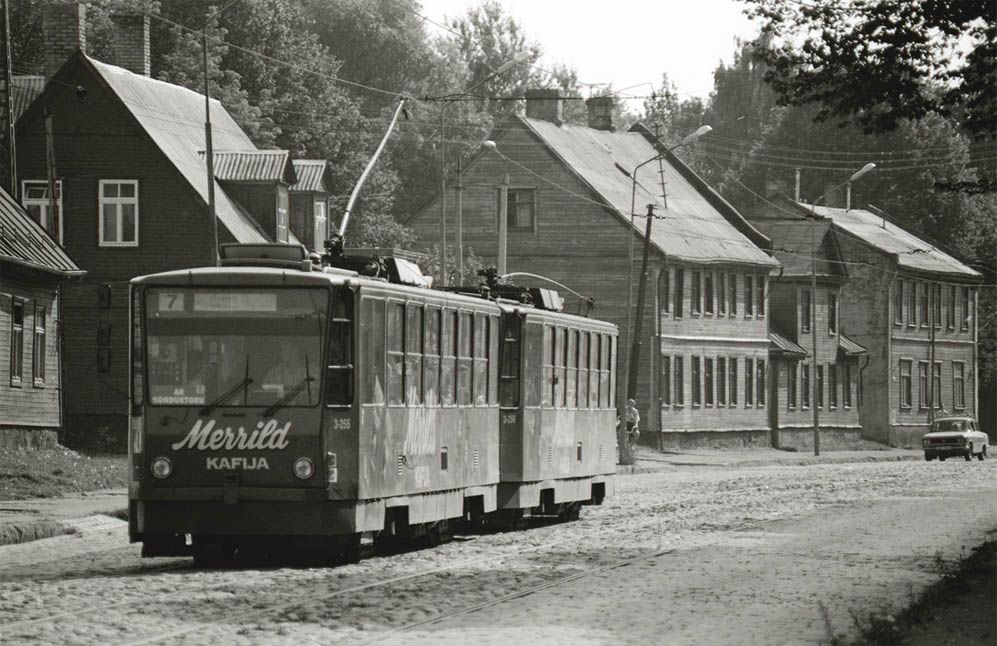
Moscow Street Trolley Car, Riga, Latvia. Photo courtesy Jono David / HaChayim Ha Yehudim Jewish Photo Library
I have just arrived in Riga, Latvia, where Kalman Aron was born.
Ten years ago, I came to Riga to research Aron’s life here after he asked me to tell his story. Born in 1924, Aron grew up in a Jewish neighborhood on Maskavas Iela, and at age 13 he painted a portrait of the Latvian President Karl Ulmanis. So impressed by his talent, Ulmanis enrolled Aron in the Riga Fine Arts Academy in 1938.
On July 1, 1941 the German Nazis entered Riga and immediately took his uncle, David, and his father, Chaim. Aron, his brother, Henech, 5 years older, and his mother, Sonya, were ordered out of their home and marched into the Riga ghetto. Kalman and Henech would spend 2 ½ years imprisoned doing slave labor. His mother, a woman who believed in a world of beauty and love, would be killed in the Rumbula forest in the winter of 1941 along with 25,000 other Riga Jews.
As I drove into the city from the airport, I caught my breath as I looked at one of the old clapboard buildings so similar to those on the street where Kalman grew up. My heart paused as we passed the imposing red stone building where Kalman went to art school—the Riga Academy of Fine Arts.
In 2004, I was excited to find Kalman’s roots. I was searching for any evidence of his life here. I found the street where he lived, Maskavas Iela; I walked among the ruins of his neighborhood Chor Synagogue (burned down in 1941 by the Germans) to the streets of the ghetto where he was imprisoned. I also honored his parents by visiting the places they were killed and having a memorial stone placed at the killing fields in the Rumbula forest.
This visit, I know so much more. In addition to Kalman, I have interviewed 5 other Latvian survivors…3 of whom lived in Latvia: Max Kit who has since died, Aleksandrs Bergmannis and Dr. Margers Vestermanis whom I will interview again, this time on film.
I am subdued, reverent and quiet. Anti-semitism is still alive in Latvia. I have read about recent incidents, one involved damaging the memorial to Zanis Lipke, a docker at the Riga cargo port who saved over 50 Jews during the Holocaust. He simply knocked on the door of a friend and said: “Here, you take care of this man or this woman.” He didn’t give them a chance to say “no.”
This time, I am fully aware of what man is capable of doing to man. Evil is real, and it had its full run over Europe under Hitler. Hitler had many accomplices. He alone could not kill six million Jews and countless others without help from citizens in all the countries occupied. Certainly, some Latvians helped the Germans kill the Jews.
I know too much.
© copyright Susan Beilby Magee, 2014.
Events
On , | In The Book | By
HAPPENING NOW
INTO THE LIGHT The Healing Art of Kalman Aron Exhibit
Los Angeles Museum of the Holocaust
September 9 – October 4
EVENT ARCHIVE : Photos + Podcasts
Susan Beilby Magee & Kalman Aron
Los Angeles Museum of the Holocaust
Sunday, March 1st, 2pm
9th Annual Conference “Jews in A Changing World,” Riga, Latvia
11.24-11.26.14
Cape May Stage, Cape May NJ
9.29.14
Smith Center for Healing and the Arts, Washington DC
6.19.14
KALMAN ARON ART EXHIBITION at Studio 55, Palm Desert CA
April 2014
Sanford-Burnham Medical Research Institute Lecture Series Group of 12 and Friends
4.2.14
Seattle Central Library
3.4.14
River Road Unitarian Universalist Congregation
2.16.14
Glendale Central Library, Glendale CA
1.9.14
San Diego Jewish Book Festival, San Diego CA
11.5.13
Smith Center for Healing and the Arts, Washington DC
6.28.13
Pheo-Para Alliance / Katzen Arts Center, Washington DC
Healing Arts Panel, Dinner & Auction
6.22.13
The Center for Living Peace, Irvine CA
6.8.13
United States Holocaust Memorial Museum, Washington DC
4.14.13
Museum of Jewish Heritage, New York NY
4.10.13
Barnes & Noble, (86th & Lex), New York NY
4.11.13
Tolerance Education Center, Rancho Mirage CA
3.7.13
Herb Nathan Educators’ Conference on the Holocaust, Scottsdale AZ
3.4.13
Politics & Prose, Washington DC
1.28.13
PODCAST
Library of Congress, Washington DC
12.4.12
WEBCAST
Washington National Cathedral, Washington DC
Crossroads Program
11.27.12
Museum of Tolerance, Los Angeles CA
10.21.12
Washington National Cathedral, Washington DC
10.13.12
Press | Print + Radio + TV
On , | In The Book | By
Jewish Book World Magazine
The Healing Artwork of A Survivor – Beliefnet.com
Hadassah Magazine
Moment Magazine “Notable Book of the Year 2012.”
Jewish Book World Magazine “A Book of Note,” Spring 2013.
The Blog From Battery Place, Museum of Jewish Heritage
RADIO
The Record, KUOW, Seattle’s NPR station
The Paul Miller Morning Show, WPHM-AM
The Vic McCarty Show, 1270 WMKT
The Business of Wisdom with Dr. Alvin Jones
WDEV-AM & FM Burlington VT, 25 min, Live, with Mark Johnson Show
KCTA-AM Corpus Christi TX, 10 min, Taped, with Morning News
WBEX-AM Chillicothe-Columbus OH, 10 min, Live, with Dan and Mike in the Morning, AM Talk Radio
WOCA-AM Ocala FL, 10 min, Live, with Larry Whitler Show
WISR-AM/Pittsburgh PA, 10 min, Taped, with The Dave Malarkey Show, AM Talk Radio
WAMV-AM Amherst VA, 10 min, Live, with Morning Show, AM Talk Radio
WLW-AM Cincinnati Ohio, 10 min, Taped, with The Jim Scott Show
TV
KMIR News Channel 6 (NBC), Palm Springs, CA
Want to know what’s happening now?
NEWSLETTER | Sign-up
Into the Light: The Healing Art of Kalman Aron
On , | No Comments | In Riga Blog | By
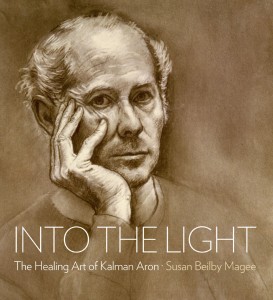
INTO THE LIGHT is a profound, visual story of hope, courage and healing in the face of evil. It relates the epic life journey of Kalman Aron who emerges from the ashes of the Holocaust to explore the nature of humankind, his own humanity and the mystery of life—all on canvas.
For all press inquiries and book-signing, lecture or panel discussion requests, please contact:
Liz Riviere
Hard Press Editions
702 896-8958
liz@hardpresseditions.com
You may reach the author, Susan Beilby Magee, at:
202 285-2200
susanbmagee@gmail.com
